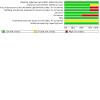Tapentadol for chronic musculoskeletal pain in adults
- PMID: 26017279
- PMCID: PMC7205027
- DOI: 10.1002/14651858.CD009923.pub2
Tapentadol for chronic musculoskeletal pain in adults
Abstract
Background: Chronic musculoskeletal pain is a prevalent condition and a major cause of disability and absence from the workplace worldwide. Opioids are frequently used to treat chronic pain, although adverse effects often restrict their long-term benefits. Tapentadol is an opioid and norepinephrine re-uptake inhibitor, which may cause a lower incidence (and severity) of adverse effects compared to other strong opioids.
Objectives: To determine the efficacy, safety and tolerability of tapentadol extended release for moderate-to-severe pain for at least three months for any musculoskeletal cause.
Search methods: We searched electronic databases (CENTRAL, MEDLINE, EMBASE, Web of Science) to March 2014, unrestricted by language, as well as trials registers and reference lists from retrieved studies. We contacted drug manufacturers for further information.
Selection criteria: Randomised controlled trials (RCTs) of tapentadol in people with chronic musculoskeletal pain, compared to placebo or active control.
Data collection and analysis: Two review authors independently selected trials for inclusion, assessed risk of bias of included studies and extracted data. We performed two meta-analyses for the comparisons tapentadol extended release vs. placebo, and tapentadol extended release vs. active-control (oxycodone). We used random-effects and fixed-effect models according to the presence or not of heterogeneity, respectively. Also, we performed subgroup analyses. The primary efficacy outcome was pain control assessed by change in pain intensity scores and responder's rate (at least 50% pain relief). Primary safety outcome was withdrawal rate due to adverse effects.
Main results: Four parallel-design RCTs of moderate quality including 4094 patients with osteoarthritis or back pain, or both, met the inclusion criteria. Three trials were phase III studies with 12-weeks follow-up and the fourth trial was an open-label safety study of 52-weeks follow-up. All trials were oxycodone-controlled and three were also placebo-controlled. Two trials included patients with knee osteoarthritis, one evaluated patients with low back pain and one enrolled both. All studies reported last-observation-carried-forward (LOCF) as imputation method. We requested baseline-observation-carried-forward (BOCF) imputed analyses and any unpublished data from the manufacturer but the manufacturers denied the request. Two out of the four oxycodone-controlled studies and one out of the three placebo-controlled studies did not provided data on responder's rate. Two studies were considered to be of high risk of bias.In comparison to placebo, tapentadol was associated with a mean reduction of 0.56 points (95% confidence interval (CI) 0.92 to 0.20) in the 11-point numerical rating scale (NRS) at 12 weeks and with a 1.36 increase (95% CI 1.13 to 1.64) in the risk of responding to treatment (number needed to treat for an additional beneficial outcome (NNTB) 16; 95% CI 9 to 57, for 12-weeks). Moderate-to-high heterogeneity was found for the efficacy outcome estimates. Tapentadol was associated with a 2.7 fold increase (95% CI 2.05 to 3.52) in the risk of discontinuing treatment due to adverse effects number needed to treat for an additional harmful outcome (NNTH) 10; 95%CI 7 to 12, for 12 weeks).In comparison to oxycodone, pooled data showed a 0.24 points (95%CI 0.43 to 0.05) reduction in pain intensity from baseline in the 11-point NRS. The two studies that evaluated responder's rate showed a non-significant 1.46 increase (95% CI 0.92 to 2.32) in the risk of responding to treatment among tapentadol treated patients. Tapentadol was associated with a 50% risk reduction (95% CI 42% to 60%) of discontinuing treatment due to adverse effects (NNTB 6; 95% CI 5 to 7, for 12 weeks). Tapentadol was also associated with a 9% reduction (95% CI 4 to 15) in the overall risk of adverse effects (NNTH 18; 95% CI 12 to 35, for 12 weeks) and with a non-significant 43% reduction (95% CI 33 to 76) in the risk of serious adverse effects. Moderate to high heterogeneity was found for most efficacy (except for the primary outcome) and safety outcome estimates. Subgroup analysis showed a higher improvement with tapentadol among patients with knee osteoarthritis and among pooled results from studies of higher quality and shorter follow-up period, although there were no statistical significant differences in the effect size between these subgroups.
Authors' conclusions: Tapentadol extended release is associated with a reduction in pain intensity in comparison to placebo and oxycodone. However, the clinical significance of the results is uncertain due to the following reasons: modest difference between interventions in efficacy outcomes, high heterogeneity in some comparisons and outcomes, high withdrawals rates, lack of data for the primary outcome in some studies and impossibility to use BOCF as imputation method. Tapentadol is associated with a more favourable safety profile and tolerability than oxycodone.
Conflict of interest statement
Vaz‐Carneiro A and Costa J are the Director and Associated Director of the Evidence Based Medicine (EBM) Center at Lisbon School of Medicine, Portugal. This research centre is devoted to pre‐ and postgraduate medical education. Since 2002, the Lisbon EBM Center has undertaken several clinical and epidemiological research projects, which had unrestricted funding from over 20 different pharmaceutical companies. One of those was the Grünenthal Group, which developed tapentadol.
The centre has not received any direct or indirect payment or other type of benefit for conducting this Cochrane review. The initiative for this project is also entirely due to the Lisbon EBM Center.
Santos J, Fareleira F, and Alarcão J are Lisbon EBM Center collaborators.
We have no other known conflicts of interest to declare.
Figures













Update of
References
References to studies included in this review
Afilalo 2010 {published data only (unpublished sought but not used)}
-
- Afilalo M, Etropolski MS, Kuperwasser B, Kelly K, Okamoto A, Van Hove I, et al. Efficacy and safety of tapentadol extended release compared with oxycodone controlled release for the management of moderate to severe chronic pain related to osteoarthritis of the knee: a randomized, double-blind, placebo- and active-controlled phase III study. Clinical Drug Investigation 2010;30(8):489-505. - PubMed
-
- Afilalo M, Kuperwasser B, Kelly K, Okamoto A, Van Hove I, Lange B, et al. Efficacy and safety of tapentadol extended release (ER) for chronic pain due to osteoarthritis of the knee: results of a phase 3 study. Pain Practice 2009;9(s1):159.
-
- Etropolski M, Lange B, Kuperwasser B, Kelly K, Okamoto A, Steup A, et al. Efficacy and safety of tapentadol extended release versus oxycodone controlled release in opioid-naive and opioid-experienced patients with chronic pain associated with osteoarthritis of the knee. Osteoarthritis and Cartilage 2009;17:S175.
-
- Kavanagh S, Ashworth J, Lange B, Etropolski MS, Van Hove I, Rauschkolb C. EuroQol-5 dimension health status questionnaire results from a randomized, double-blind, placebo- and active-controlled Phase 3 study of tapentadol extended release (ER) for the management of chronic osteoarthritis knee pain. Value Health 2009;12(7):A433-4.
-
- Kelly K, Etropolski M, Kuperwasser B, Okamoto A, Steup A, Van Hove, et al. Similar analgesic effect and improved tolerability of tapentadol extended release (ER) versus oxycodone controlled release (CR) for treatment of chronic osteoarthritis (OA) knee pain: results from a randomized, double-blind, phase 3 trial. Rheumatology 2010;49:i79.
Afilalo 2013 {published data only (unpublished sought but not used)}
-
- Afilalo M, Morlion B. Efficacy of tapentadol ER for managing moderate to severe chronic pain. Pain Physician 2013;16(1):27-40. - PubMed
-
- Etropolski M, Lange B, Goldberg J, Steup A, Rauschkolb C. A pooled analysis of patient-specific factors and efficacy and tolerability of tapentadol extended release treatment for moderate to severe chronic pain. Journal of Opioid Management 2013;9(5):343-56. - PubMed
-
- Merchant S, Provenzano D, Mody S, Ho KF, Etropolski M. Composite measure to assess efficacy/gastrointestinal tolerability of tapentadol ER versus oxycodone CR for chronic pain: pooled analysis of randomized studies. Journal of Opioid Management 2013;9(1):51-61. - PubMed
Buynak 2010 {published data only (unpublished sought but not used)}
-
- Buynak R, Etropolski M, Lange B, Shapiro D, Douglas Y, Okamoto A, et al. Dose stability of tapentadol ER for the relief of chronic low back pain: results of a randomized, active- and placebo-controlled study. Arthritis and Rheumatism 2009;60:1494.
-
- Buynak R, Shapiro D, Okamoto A, Lange C, Etropolski M. Efficacy, safety, and gastrointestinal tolerability of tapentadol ER in a randomized, double-blind, placebo- and active-controlled phase III study of patients with chronic low back pain. Journal of Pain 2009;1:S48.
-
- Buynak R, Shapiro D, Okamoto A, Van Hove I, Etropolski M. Efficacy and safety of tapentadol ER for chronic low back pain: results of a randomized, double-blind, placebo- and active-controlled phase III study. Journal of Pain 2009;1:S50. - PubMed
-
- Buynak R, Shapiro D, Okamoto A, Van Hove I, Rauschkolb C, Steup A, et al. Efficacy and safety of tapentadol extended release for the management of chronic low back pain: results of a prospective, randomized, double-blind, placebo- and active-controlled Phase III study. Expert Opinion on Pharmacotherapy 2010;11(11):1787-804. - PubMed
-
- Buynak R, Shapiro DY, Okamoto A, Van Hove I, Rauschkolb C, Steup A, et al. Erratum: efficacy and safety of tapentadol extended release for the management of chronic low back pain: results of a prospective, randomized, double-blind, placebo- and active-controlled Phase III study (Expert Opinion on Pharmacotherapy (2010) 11(11): 1787-804). Expert Opinion on Pharmacotherapy 2010;11(16):2773. - PubMed
Wild 2010 {published data only (unpublished sought but not used)}
-
- Biondi D, Xiang J, Lange R, Etropolski M, Vorsanger G, Moskovit B. Safety and tolerability of tapentadol extended release (ER) versus oxycodone controlled release (CR) in elderly patients with chronic low back or osteoarthritis pain. Journal of Pain 2010;1:S42.
-
- Biondi D, Xiang J, Lange R, Etropolski M, Vorsanger G, Moskovitz B. Tapentadol extended release (ER) versus oxycodone controlled release (CR) for management of chronic low back or osteoarthritis pain: Analyses of study discontinuations due to constipation, nausea, or vomiting. Journal of Pain 2010;1:S42.
-
- Biondi D, Xiang J, Vorsanger G, Moskovitz B, Ashworth J, Etropolski M. Tapentadol extended release (ER) versus oxycodone controlled release (CR) for management of chronic low back or osteoarthritis pain: Influence of prior opioid experience on study discontinuations due to constipation, nausea, or vomiting. Journal of Pain 2010;1:S42.
-
- Blondi D, Xiang J, Lange R, Etropolski M, Vorsanger G, Moskovitz B. Tolerability of tapentadol extended release versus oxycodone controlled release in elderly patients with chronic low back or osteoarthritis pain in a 1-year safety study. Der Schmerz 2010;24(S1):92.
-
- Grond S, Kuperwasser B, McCann B, Etropolski M, Lange R, Lange B, et al. Dose stability of tapentadol extended release and oxycodone controlled release in a one-year, randomized, open-label, phase 3 safety trial in patients with chronic low back or osteoarthritis pain. Osteoarthritis and Cartilage 2009;17:S181-2.
References to studies excluded from this review
Ashworth 2010 {published and unpublished data}
-
- Ashworth J, Kuperwasser B, Etropolski M, Lange B, Lange R, Häufel T. Assessment of opioid withdrawal in patients treated with tapentadol prolonged release during an open-label extension study. Osteoarthritis and Cartilage 2010;18:S148.
-
- Kuperwasser B, McCann E, Van Hove I, Lange R, Häufel T, Etropolski M. Health status of patients who received tapentadol prolonged release during an open-label extension study. Osteoarthritis and Cartilage 2010;18:S149.
-
- McCann B, Lange R, Wagner B, Steup A, Lange B, Etrolpolski M. Patient Global Impression of Change results from a 1-year open-label extension study of tapentadol extended release in patients with chronic osteoarthritis or low back pain. Arthritis and Rheumatism 2010;62:950.
Gálvez 2013 {published and unpublished data}
-
- Gálvez R, Schäfer M, Hans G, Falke D, Steigerwald I. Tapentadol prolonged release versus strong opioids for severe, chronic low back pain: results of an open-label, phase 3b study. Advances in Therapy 2013;30(3):229-59. - PubMed
Lange 2010 {published and unpublished data}
-
- Lange B, Kuperwasser B, Okamoto A, Steup A, Häufel T, Ashworth J, et al. Efficacy and safety of tapentadol prolonged release for chronic osteoarthritis pain and low back pain. Advances in Therapy 2010;27(6):381-99. - PubMed
Additional references
Andersson 1993
-
- Andersson HI, Ejlertsson G, Leden I, Rosenberg C. Chronic pain in a geographically defined general population: studies of differences in age, gender, social class, and pain localization. Clinical Journal of Pain 1993;9(3):174-82. - PubMed
AUREF 2012
-
- Cochrane Pain, Paliative and Supportive Care Group. PaPaS Author and Referee Guidance (AUREF), 2012. papas.cochrane.org/papas-documents (accessed March 2014).
Breivik 2000
-
- Breivik EK, Björnsson GA, Skovlund E. A comparison of pain rating scales by sampling from clinical trial data. Clinical Journal of Pain 2000;16(1):22-8. - PubMed
Breivik 2006
-
- Breivik H, Collett B, Ventafridda V, Cohen R, Gallacher D. Survey of chronic pain in Europe: prevalence, impact on daily life, and treatment. European Journal of Pain 2006;10(4):287-333. - PubMed
Buskila 2000
-
- Buskila D, Abramov G, Biton A, Neumann L. The prevalence of pain complaints in a general population in Israel and its implications for utilization of health services. Journal of Rheumatology 2000;27(6):1521-5. - PubMed
Chou 2009
Crombie 1999
-
- Crombie IK, Croft PR, Linton SJ, LeResche L, Von Korff M (editors). Epidemiology of Pain. Seattle: IASP Press, 1999.
Farrar 2001
-
- Farrar JT, Young JP Jr, LaMoreaux L, Werth JL, Poole RM. Clinical importance of changes in chronic pain intensity measured on an 11-point numerical pain rating scale. Pain 2001;94(2):149-58. - PubMed
Freynhagen 2006
-
- Freynhagen R, Baron R, Gockel U, Tölle TR. painDETECT: a new screening questionnaire to identify neuropathic components in patients with back pain. Current Medical Research and Opinion 2006;22(10):1911-20. - PubMed
Higgins 2011
-
- Higgins JPT, Green S (editors). Cochrane Handbook for Systematic Reviews of Interventions Version 5.1.0 [update March 2011]. The Cochrane Collaboration, 2011. Available from www.cochrane-handbook.org.
IASP 1986
-
- International Association for the Study of Pain, Subcommittee on Taxonomy. Classification of chronic pain. Descriptions of chronic pain syndromes and definitions of pain terms. Pain. Supplement 1986;3:S1-226. - PubMed
Jadad 1995
-
- Jadad AR, Brownman GP. The WHO analgesic ladder for cancer pain management. Stepping up the quality of its evaluation. JAMA 1995;274(23):1870-3. - PubMed
LeResche 2000
-
- LeResche L. Epidemiologic perspectives on sex differences in pain. In: Fillingim RB, editors(s). Sex, Gender, and Pain. Progress in Pain Research and Management. Vol. 17. Seattle: IASP Press, 2000:233-49.
Manchikanti 2011
-
- Manchikanti L, Ailinani H, Koyyalagunta D, Datta S, Singh V, Eriator I, et al. A systematic review of randomized trials of long-term opioid management for chronic non-cancer pain. Pain Physician 2011;14(2):91-121. - PubMed
Marcus 2000
-
- Marcus DA. Treatment of nonmalignant chronic pain. American Family Physician 2000;61(5):1331-8. - PubMed
McAlindon 1992
-
- McAlindon TE, Cooper C, Kirwan JR, Dieppe PA. Knee pain and disability in the community. British Journal of Rheumatology 1992;31(3):189-92. - PubMed
Moher 2009
Moore 2002
Moore 2010
-
- Moore RA, Eccleston C, Derry S, Wiffen P, Bell RF, Straube S, et al ACTINPAIN Writing Group of the IASP Special Interest Group on Systematic Reviews in Pain Relief, Cochrane Pain, Palliative and Supportive Care Systematic Review Group Editors. "Evidence" in chronic pain-establishing best practice in the reporting of systematic reviews. Pain 2010;150(3):386-9. - PubMed
Nüesch 2009
Papageogiou 1995
-
- Papageogiou AC, Croft P, Ferry S, Jayson MIV, Silman AJ. Estimating the prevalence of low back pain in the general population. Evidence from the South Manchester Back Pain Survey. Spine 1995;20(17):1889-94. - PubMed
Reisine 2001
-
- Reisine S, Fifield J, Walsh SJ, Feinn R. Factors associated with continued employment among patients with rheumatoid arthritis: a survival model. Journal of Rheumatology 2001;28(11):2400-8. - PubMed
RevMan 2014 [Computer program]
-
- The Nordic Cochrane Centre, The Cochrane Collaboration Review Manager (RevMan). Version 5.3. Copenhagen: The Nordic Cochrane Centre, The Cochrane Collaboration, 2014.
Riemsma 2011
-
- Riemsma R, Forbes C, Harker J, Misso K, Liedgens H, Schaefer M, et al. A systematic review of tapentadol in chronic moderate to severe pain. Value in Health 2011;14(7):A411. - PubMed
Trescot 2008a
-
- Trescot AM, Helm S, Hansen H, Benyamin R, Glaser SE, Adlaka R, et al. Opioids in the management of chronic non-cancer pain: an update of American Society of the Interventional Pain Physicians' (ASIPP) guidelines. Pain Physician 2008;11(2 Suppl):S5-62. - PubMed
Trescot 2008b
-
- Trescot AM, Datta S, Lee M, Hansen H. Opioid pharmacology. Pain Physician 2008;11(2 Suppl):S133-53. - PubMed
Trescot 2008c
-
- Trescot AM, Glaser SE, Hansen H, Benyamin R, Patel S, Manchikanti L. Effectiveness of opioids in the treatment of chronic non-cancer pain. Pain Physician 2008;11(2 Suppl):S181-200. - PubMed
Urwin 1998
-
- Urwin M, Symmons D, Allison T, Brammah T, Busby H, Roxby M, et al. Estimating the burden of musculoskeletal disorders in the community: the comparative prevalence of symptoms at different anatomical sites, and the relation to social deprivation. Annals of the Rheumatic Diseases 1998;57(11):649-55. - PMC - PubMed
WHO 2010
-
- World Health Organization. WHO's pain relief ladder 2010. www.who.int/cancer/palliative/painladder/en (accessed 30 April 2012).
Publication types
MeSH terms
Substances
LinkOut - more resources
Full Text Sources
Medical
Miscellaneous

